This page forms part of Dr Peter Harries’ first PhD thesis submission entitled: “From Local ‘Live’ Production Houses to Relay Stations: A History of Commercial Television in Perth, Western Australia 1958-1990″. This contained much additional material.
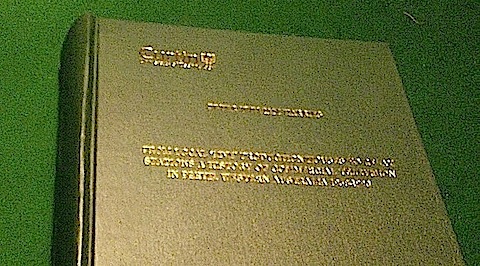
Chapter One:
In the beginning. The circumstances surrounding the granting of the first two Commercial TV Licences in Western Australia to TVW Limited In 1958 and Swan Television Limited in 1964:
Introduction:
More than thirty years ago Tunstall said, ‘A continuous theme has been opposition to the goals of media proprietors – for instance the political goals of newspaper owners, or the commercial goals adopted in television programming.’ The first part of that statement was clearly illustrated in the contest to possess the first commercial television licence in Western Australia. Whilst one of the adversaries, West Australian Newspapers Limited, championed the cause of keeping Western Australian television in the hands of Western Australians, the other, headed by now media magnate Rupert Murdoch, based its argument on its belief that too much control would be placed in the same hands, thereby creating a media monopoly reword. The peculiar facet was that in this case it was one media proprietor (Rupert Murdoch, with the same goals), finding an excuse for opposing the intentions of his opposition (strategy for arguing self interest). In both 1958 and 1964 News Limited was twice defeated by West Australian Newspapers Limited, in its efforts in to obtain the second Western Australian licence. Swan Television was successful in acquiring the second commercial licence in 1964. In short, Rupert Murdoch was twice frustrated and in both cases a major player was the first General Manager of TVW Limited, James Winter Cruthers. Cruthers commenced work as an office-boy in 1939 at W.A. Newspapers as an office- boy before serving in the R.A.A.F. On his return he studied English, History and Economics at night school and in 1947 achieved a position at the Daily News as a journalist. By 1958 when he was editor of the Weekend Mail, he was put in charge of gaining the first Western Australian commercial television licence for his employers. Eventually Managing Director of TVW7, he ‘retired’ in 1981 and then worked in New York for ten years for Rupert Murdoch. He still does so, in an advisory capacity at the Perth Sunday Times.
This chapter examines the circumstances surrounding the contest for the first Commercial Television Licence in Western Australia. The contenders were those who controlled West Australian Newspapers Ltd., and those who supported their opposition, the Adelaide based News Limited (through their local subsidiary Western Press Limited, the publishers of the Sunday Times). The chapter looks at the difficulty experienced in trying to interest local investors in the project; the subsequent inquiry conducted by Australian Broadcasting Control Board and the granting of the licence to TVW Limited. It shows that there was a demonstrated undertaking to foster local ‘live’ production with anticipated program content from that source proposed at 41%. The chapter then analyses the granting of the second commercial licence to STW9. This time the opponents were Western Television Services representing ‘the Establishment’ (once again sponsored by Rupert Murdoch through Adelaide’s News Limited) and Swan Television Limited, in the main a group of independent Perth businessmen.
In an attempt to gauge public reaction to a share-market float and to provide the necessary capital for the establishment of a television station, in November 1957, the Board of Directors of West Australian Newspapers Limited ran the following advertisement on a daily basis for two weeks in both the The West Australian and the Daily News.
TELEVISION
IN WESTERN AUSTRALIA
West Australian Newspapers Ltd. is considering participation in commercial television
in Western Australia. Applications for licences will close on June 30 next.
The Company wishes to make an application in conjunction with other parties and
would appreciate information from anyone interested on the following points:
1. How much the party could contribute in initial capital.
2. Any capacity to continue to support the station financially during the
first five years of operation, if additional calls needed to be made.
3. Any other conditions of joining in the application.
All information will be treated as confidential.
Applications in writing only will be received.
Applications should be addressed to:
Television Station (Confidential)
The Secretary, West Australian Newspapers Ltd., Newspaper House,
St George’s Terrace, Perth.
On the morning of 28 January 1958, the editor of the Weekend Mail, James Cruthers, was summoned to the office of the chief executive of West Australian Newspapers, James Edward Macartney and given these instructions, ‘Get me the first television license for Western Australia!’.
Working from a small basement office at the side of Newspaper House in St. George’s Terrace, Cruthers set about building the new venture. He co-opted Brian Treasure, a successful advertising salesman from within the newspaper company, an accountant Frank Moss and Judith Copley as his secretary. An astute judge of character and potential, Cruthers was satisfied that he had chosen the best people available.This combination would prove to be a most productive and enduring business association.
Possessing a little knowledge but no practical experience of television, Cruthers used his considerable newspaper background and editing skills to prepare a 67 page document entitled,
TVW LIMITED
INFORMATION IN SUPPORT
OF AN APPLICATION FOR A
LICENCE
for a
COMMERCIAL TELEVISION STATION
At
PERTH, WESTERN AUSTRALIA
The information provided was designed to establish the position of strength which had been attained by the Company since its establishment (as The Perth Gazette) within twelve months of the settlement of Western Australia. An introductory chapter outlined a short history of West Australian Newspapers Ltd., together with the then current position of that company, along with circulation figures of its various publications.

The company had a last audited balance sheet showing assets exceeding liabilities by £2,029,392. The net tangible asset backing for each one pound share was one pound sixteen shillings and three pence. Revenue for the previous fiscal year was £3,352,000 and the then current one pound shares were being quoted on the Stock Exchange at two pounds and nineteen shillings. No argument could be mounted regarding the fiscal solidity of the organisation. Much was made of the fact that the company was 83.5% owned by West Australians, with the largest shareholder, (identified by Cruthers as probably being the Catholic Church ) owning 13,524 shares, being 1.21% of the total issue. The theme of being ‘local’ would subsequently be one of the main policy planks leading to the success of the application and then carried through to the present day by TVW7. Only two other shareholders held more than 5,000 shares. The detail of shareholdings was illustrated thus:
No. of holders % of shares No. of shares % of total
West. Aust.
residents 1839 81.35 934,068 83.5
East. States
residents 386 17.06 163,618 14.64
Overseas
residents 36 1.59 20,852 1.86
An analysis of the Company structure showed that 88.62% of its shares were held in parcels of less than 1000. This is evidence of the broad supporter base of the new television station as represented by the obvious interest of the Western Australian general public. The broad base of the Company reflects upon the amount of control which was vested in the Managing Editor, James Edward Macartney.
In 1928 J.E.Macartney, as a student at the University of Western Australia was suspended as result of unacceptable content in the journal Pelican of which he was Editor. Aged 20 he was employed at West Australian Newspapers Limited by C.P. Smith and subsequently set up the weekly Broadcaster. Four years later he was appointed Editor of the Daily News.
At West Australian Newspapers Macartney was in absolute control and held his position not through personal financial involvement, but rather through recognition of his personal acumen by the Company Directors. At that time such representatives of private enterprise held their positions because of their obvious suitability to their positions and not because of their having acquired control of the particular commercial operation through monetary manipulation. Sir James Cruthers doubted that Macartney ever held any shares in West Australian Newspapers Limited or in TVW Limited.
The following analysis of the shareholders showed that 72.05% of the subscribers held up to 500 shares.

This broad supporter base was doubtless due to the perceived (and real) strength of West Australian Newspapers Limited. It reflected on the stature of James Macartney, which transferred to the persona of James Cruthers in subsequent years. These two men knew that their shareholders were those who would constitute a very good representation of the viewing audience. There was a section outlining the policy of service to the State and its people, the modernity of its production equipment, its independence from out of state influences and the operation of an overseas and interstate agency for the dissemination of information through the Perth News Bureau. Another section outlined the methods employed in overcoming the State’s tyranny of distance and also the promotion of Western Australia’s vast and unused hinterland, particularly the potential [the magnitude of which was not envisaged] of the North -West. The final chapter in this section outlined the work of West Australian Newspapers Limited in assisting charitable organizations. This was both by way of assistance in community fund-raising and straight-out donations of cash. This type of community responsibility would become a continuing theme in the operation of TVW7.
The response was negative to say the least, with four serious proposals put forward. One was from a local electrical goods retailer who suggested that he had ‘liquid capital’ of between £50,000 and £100,000. However, an offer of participation by W.A. News Ltd., to that trader was not taken up. The second was a verbal offer by a Perth businessman, purporting to be acting on behalf of a Trade Union with £100,000 to invest, but nothing more came of this. There was another written offer to invest £25,000, but these funds would not be available until June 1959 following settlement for the sale of an omni-bus business to the Government. The fourth and only other offer came from a private person who had £300 to £500 to invest.
Despite the lack of interest, on 2 May 1958 the Managing Editor James Macartney sent letters over his personal signature to 44 of Western Australia’s acknowledged leading institutions and concerns. These included local retailers and business houses, all local radio stations, all major church organizations, the Labor Party, the Liberal Party, the Country Party, the Chamber of Commerce and Manufacturers, theatre interests, the Farmer’s Union, and the Sunday Times and all country newspapers. It must be a reflection upon the degree of business confidence existing in Western Australia at this time, in that there was little more response to this direct approach by James Macartney than there had been to the public advertisement in The West Australian and the Daily News.. By 10 June 1958 there had been an offer from the Roman Catholic Church to invest £10,000 and £500 from each of two country newspapers.
In light of the acknowledged success of the commercial stations which had been operating in the Eastern States capitals for almost two years, the degree of reticence displayed by the community seems surprising. However, it must be remembered that Western Australia generally was undergoing one of its ‘Cinderella’ periods and there had not been the recovery in facets of primary and secondary industry as had been experienced elsewhere in Australia. Ghosh said ‘…after 1966 the contribution of mining…to total production increased rapidly…thereby reversing the earlier trend of the 1950s and the early 1960s.’
Although the Australian Labor Party held the treasury benches of the Legislative Assembly from 1953 until 1959 if fancy number-plates had been available for motor cars, they might have read ‘The Conservative State’. In September 1956 I resigned from my job as wages clerk, counter-jumper, mail and bank runner etc., at the Perth Sunday Times and evidence of prevailing economic conditions in Western Australia are apparent in the reason. When I turned twenty-one, the Company Secretary Jack Mitchell told me that as times were so tough, I could only increase my wages from £10 per week to the basic-wage of £11.4.0. The ‘margin’ of £1 per week which I had been promised to me was not available. I clearly remember Mr. Mitchell saying to me, ‘You had better think very clearly about this my boy! Just look in the paper! You won’t find a single clerical job for a bloke your age!’ To illustrate the point, I went to Sydney where clerical work was in abundance and within six months I was working at the Sydney Morning Herald, earning £18 per week. Journalist/Author Robert Drewe reported a similar circumstance when in 1967 he was ‘head-hunted’ by a Melbourne newspaper. The incentive was a $30 per week more than he was receiving at The West Australian. Ghosh maintains that Western Australia remained a ‘backward’ State until the development of mining in the 1960s.
In spite of the perceived lack of interest by organized community groupings to participate in the formation of a television company, the directors of West Australian Newspapers Ltd., decided to go ahead with access to shares being made available to the public. To this end TVW7 Limited filed a Prospectus with the Registrar of Companies on 30 June 1958. Authorised capital was to be £1,000,000 divided into 2,000,000 ten shilling shares. The paid up capital was £201/10/- . West Australian Newspapers had untaken to subscribe for 600,000 shares, 600,000 were offered for public subscription and the remaining 800,000 shares were to be held in reserve. The estimated £600,000 to £700,000 required would come from a contribution by the directors of West Australian Newspapers Ltd., to be provided by a bank loan. For that purpose the Bank of New South Wales approved an advance of £300,000. Should the application for the licence be successful, the remaining 600,000 to 800,000 shares would be opened to public subscription at the same par figure. There would also be non-secured 10-year notes returning 7% interest p.a., exchangeable for shares after three years.
Application for a Licence for a Commercial Television Station at Perth, Western Australia:
It was noted in the licence application that the interest of TVW Limited to secure a telecasting licence was subject to there being only one commercial licence issued at that time for the Perth area. The reason given for this proviso was the sparse population of the Perth Metropolitan area in comparison to capital cities in the Eastern States. TVW Limited claimed that there would not be enough advertising revenue in Perth to support two commercial stations. In Melbourne, Sydney, Brisbane and Adelaide two licences had been granted for the introduction of transmission.
In regard to technical matters, Television Engineering Pty. Ltd., had been engaged as technical advisers. Following the positive experiences in the Eastern States, Pye equipment would be used or, in lieu, any better product available. It was stated that as TVW Limited were completely independent of any suppliers they could consider all makes of television equipment. If necessary they would use a combination ‘so that the proposed television station will be the best it is possible to build.’ The schedule of technical equipment ran to 39 pages.
Amongst the detail of the proposed television company were listed the directors to be of TVW Limited.
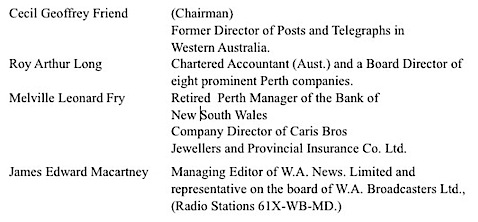
The acting General Manager was James Winter Cruthers and the acting Secretary was Jack Ramsay.
Section (7) of the application required an estimated cost of station establishment. The provided figure totalled £479,370, and technical equipment was costed at £193,470. First year operating costs would be £257,738, second year £269,838 and third year £319,418. Based on information from operational stations in Sydney and Melbourne, it was estimated that advertising income in the first year would be £132,977, the second year £232,537 and the third year £378,976. This provided estimated trading figures of two annual losses of £124,761 and £37,301, followed by a profit in the third year of £59,558. These estimates were in part based on the experience in the Eastern States. GTV9 Melbourne had reported that the station ‘got out of the red’ in less than a year of operation. In May 1956 TCN9 Sydney expected the station to show ‘an overall profit…only in its second year of operation.
A staff of 61 persons was envisaged being Commercial and General (11), Sales (6), Programming and News (19), Film department (7) and Technical (18). Hours of operation were planned at 35 hours in the first year, 42 hours in the second and a minimum of 50 hours in the third year.
The application then addressed intended transmission times and program content. TVW Limited’s commitment to local ‘live’ production was spelt out in the first part of this submission.
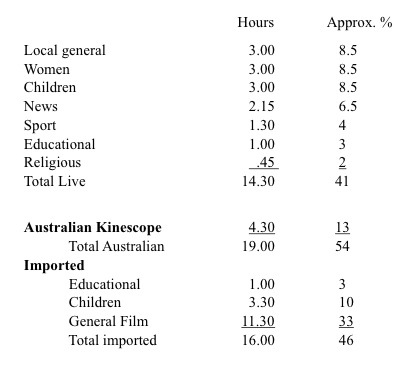
Australian Kinescope refers to the only way that programs originating in Eastern States television studios could be shown in Perth. A Kinescope recording was on 16mm black and white film, ‘shot’ directly from a small television picture tube. The process always produced a ‘grainy’ result and the re-televised product was subject to ‘flair’ where the lighter parts of the picture (although on the television ‘grey scale’ never exceeded about 92% of ‘whiteness’) have the appearance of being ‘brighter’ than surrounding areas. It is also interesting to note that there was a commitment to ‘religious’ programs. A simulated programme for a full week showed a usual commencement time of 5.30 p.m., each day. This excepted Tuesdays and Thursdays when there would be one and a half hours of ‘local women’s’ programming starting at 2.30 p.m. In commenting on programme sources, the licence application stressed the importance of local ‘live’ shows and displayed much detail of intended content. In light of this, it is surprising that during the three days during which testimony was given at the Australian Broadcasting Control Board hearing in Perth in July 1958, not one question approached the subject of local production.
On 28 July 1958, under the auspices of The Broadcasting and Television Act 1942-1956, an inquiry was held by the Australian Broadcasting Control Board in Perth. The purpose was to examine applications received for licences for commercial television stations in the Perth area. The Board consisted of Messrs R.G. Osborne (Chairman) R.B. Mair, R.A. Yeo and R.M. White (Members) and J. O’Kelly (Secretary). The inquiry was in respect of applications from TVW Limited and Western Television Services Ltd. Counsel representing the applicants were Messrs. R.I. Ainslie and H.V. Reilly appearing for TVW Limited; Messrs. O. Negus Q.C., and G.W. Gwynne appearing for Western Television Services Limited and Harry Alderman Q.C., and R.J. Clark appearing for Western Press Limited.
The main witness for TVW Limited was West Australian Newspapers boss J. E. Macartney and for Western Television Services Limited (a group headed by Rupert Murdoch) was Sir Alexander Reid. The former argued that they should be granted the licence as they were ‘local’ while the latter claimed that granting the licence to TVW Limited would amalgamate too much power in the hands of W.A. Newspapers Ltd. The licence was granted to TVW Limited to operate as TVW7.
During the Hearings Rupert Murdoch gave evidence and a question regarding potential ‘domination’ by him was answered thus,
I will retire as soon as I possibly can. I only manage as it is to come over here 3 or 4 times a year. I hope I will have even less time to do so in the future. I certainly have not got the power or the inclination. There is no attempt to build an empire or anything like that. It would not interest me.
This must rank as one of the most notable recorded under-estimations of personal ambition and ability in all of Australian history.
Proposal to Grant a Second Perth Commercial Licence:
The Formation of Swan Television Limited:
According to Swan Television’s former Chairman of Directors Dennis Cullity, the idea to form the Company is credited to Bob McKerrow who was the Assistant State Manager of the E.S. and A. Bank Cullity said that McKerrow was a very industrious person who ‘had gone around creating opportunities for clients.’ Amongst those were Dan O’Sullivan of General Agency [which subsequently became Town and Country Bank] and Bernie Prindiville. A meeting between McKerrow, Prindiville and Cullity led to the formation of Swan Television Ltd.
The company was incorporated on 25 July 1963, with an authorized capital of £250,000 which was increased on 8 August 1963, to £300,000 divided into 600,000 shares of 10s. each, of which 540,000 had been issued to sponsors and called to 6d each. If the company was granted the license it was proposed again to increase authorized capital to £1,000,000 and to make a public issue of a further 600,000 shares of 10 shillings each, hereby increasing the issued capital to £600,000.
Shareholdings would then be,
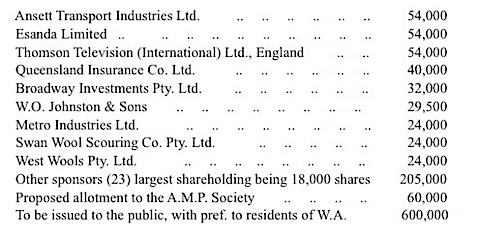
Of these, W.O. Johnston & Sons was a wholesale meat firm headed by Fred Johnston and the wool companies belonged to Bill Hughes. Subsequently Bill Young the owner of Attwood Motors joined them along with David Bell of Bell Brothers [a very large trucking and earth-moving business]. A successful financial adviser in Horrie Stewart was also co-opted for his skill in that capacity and a solicitor named David Speed.
The sponsors had agreed not to dispose or otherwise transfer any beneficial interest in shares taken up by them for a period of five years, without the consent of the directors. Subsequently, when neither Ansett Transport Industries Ltd., Esanda Limited, the A.M.P. Society nor Queensland Insurance Co. Ltd., took up shares in Swan Television Limited, the remaining big investors (sometimes termed The Catholic Mafia because of their religious affiliations) consolidated their control and remained in charge until the Bond Corporation takeover in 1984.
By 1970 the only other large shareholder in Swan Television excepting the local businessmen was Thomson Television who still had 12.5% of the stock. The Board found out that about 8-10% of the shares had been bought by a South Australian Stockbroker secretly acting for Rupert Murdoch. Fearing a potential controlling vote if Murdoch got hold of the Thomson holding, Cullity convinced the other members of the Board that they should offer a premium of 20-25% to buy the Thomson shares. The older members of the Board were aghast at this outlay and claimed that if someone went to London to negotiate they could get the holding for a lot less. Cullity prevailed, as he considered time to be the essence and the risk of losing too great.
The original ninety page Application for the Grant of a Licence for a Commercial Television Station in the Perth Area contained information regarding the proposed company; its Directors; its association with any other television station; any commitments to net-working; estimated cost of establishment including technical equipment; radiating structure [transmission tower]; land; buildings and pre-operational expenses; estimates of operating cost for three years; capital funds available; proposals for recruiting and training staff; proposed hours of service for first three years; proposed composition of programs; details of technical facilities and location of transmitter and studios.
Schedule 8 of the Application dealt with estimate proposals for recruiting and training staff.
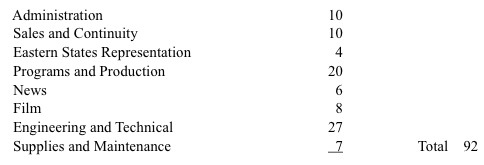
In actuality, when STW9 went to air in June 1965 there were about 120 people employed in the various departments. Most of the extra numbers were in the Production area and were the first to ‘go’ when the station sailed into stormy financial seas after a couple of months’ operation. These matters are dealt with in subsequent chapters.
As a requirement for inclusion in the application, the proposed times during which content would be transmitted were recorded as,
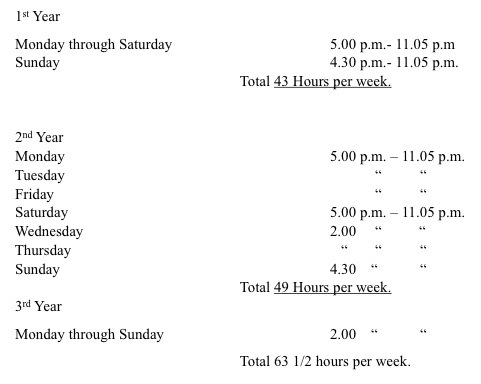
It was estimated that of the 43 hours in the first year, 21 hours or 48.8% would be dedicated to Australian programs. Of those, 13 hours (including News) would be locally produced. Total expenditure on programs per annum would be £260,000. Of this £117,000 would be Australian (£56,680 for local “live” and £60,320 for other). On a costing basis, local “live’ was estimated at £114 per hour; other Australian at £145 and ‘imported’ programs at £125 per hour.
A ‘live’ Junior Club was planned for each weekday in the 5.30 timeslot, ‘devoted mainly to the entertainment of children, the broader educative possibilities …will not be overlooked…the aim being to present children with challenging ideas and thoughts…’ There would be a “Pets Corner”; topics of current interest; accounts of outstanding features in Australia’s history, including achievements in music, literature, painting and other classic arts. A stated intention was to ‘bring to our young viewers, through film clips, graphics and possibly live interviews. Those aspects of Australian life that depict the courage, initiative and ingenuity of its people.’ The program would steer away from competitions featuring ‘large or easily-won prizes which tend to give children a false sense of values’. [I am pleased to be able to record that those intentions were carried through to a large degree by my associates and me in the first four years of the operation of STW9. A description of these actual programs is contained in Chapter Four regarding Local ‘Live’ Television.]
A 6.30 News program promised to cover ‘…international and national scenes…local news, community information…emphasis will be placed upon the local scene and opportunities taken to elucidate the news as it applies to Perth…’ It was the intention of Swan Television to have a current affairs program called Here and Now from 8.30 to 9 p.m. Monday, Wednesday and Friday ‘…deliberately placed at a peak viewing hour…’ with ‘…opportunities for the expression of the views of minority groups.’ This did not happen as those in charge of program placement rightly decided that the majority of viewers would choose watch the usual fare served at that time of night on commercial television, being American situation comedies like I Love Lucy, detective series such as 77 Sunset Strip and ‘bang-gotchas’ like Bonanza or Gunsmoke. The Girls Will Tell You was to be an earlier version of Beauty and The Beast with ‘four prominent Perth women…’ and a male compere, ‘…frivolous or serious, but always they will have the quality of topicality.’ This type of program did not eventuate either. Stars in Your Eyes was to be a thirty-minute talent quest at 10 p.m. on Tuesdays. It was expected to be‘…fast moving, entertaining variety programme that will offer great scope for local talent of all descriptions…’ This proposal was pure speculation and four years passed before STW9 attempted such a program. Another show was to be a Thursday night Quiz Program alternating between schools and ‘adults’ with great emphasis on ‘West Australian and Australian topics and on general current affairs…’ so that it would be generally informative. The type of program was never produced on STW9 although TVW7 have had ongoing success with It’s Academic instigated in 1968 and revived in 2001. [In the area of children’s television, between 1965 and 1969 I did conduct regular programs which included quiz competitions between schools and children’s talent quests.] Studio Downbeat promised a half hour of music and dance for ‘…the younger sections of the community…’ to be aired at 10 p.m. on Fridays. In actuality, the first such program on STW9 was Pad Nine on Saturday afternoons, but it was withdrawn after a short ‘run’ due to economic strictures. You and The Law was to be shown at 10 p.m. on Friday nights to explain ‘…the law and would be of interest to the lay-man.’ It would alternate with Insight, an ABC type program designed to ‘…broaden our viewer’s horizons of knowledge…sculpture, painting, music appreciation, amateur radio, shipbuilding, deep sea fishing, career guidance…bird recognition, sea-shore life…’ Neither program was ever produced as such. The reason for including such proposals was to impress the Broadcasting Tribunal with the depth and scope of the applicant’s intentions. In later reality, the Program Directors again correctly concluded that such programs were best left to the National Public Carrier. On Saturday nights from 7-8 p.m. there was to be Sports Round-Up. This became a short program when first the station went to air but did not last for very long. One program which was initiated was a religious program called Seek The Truth which ran for about ten years.
In the second year of operation, it was intended that there be a twice weekly Woman’s Hour. This would include news, advice and information about the family and home; a home nursing series with a qualified ‘sister’; short films of interest to women; light entertainment in the form of games, quizzes and competitions. In the third year, this would be on a daily basis. In 1966, such a program was instituted and continued for many years in different guises. Civic Forum, to be aired on Sundays at 2 p.m. was to be a thirty minute showcase for the Government, Perth City and Suburban Councils and various public bodies to report to the public on their activities. Some viewers would consider it a good thing that this idea did not come to fruition. The balance of the application concerned itself with technical matters and equipment.
Western Television Services Ltd., was incorporated on 13 June 1958, with an authorized capital of £1,000,000 divided into 4,000,000 shares of 5 shillings each. The company, in 1958, was an unsuccessful applicant for the first commercial television license to be granted for the Perth area.
At the date of this application only ten fully paid shares had been issued. If the company were granted the license, it was proposed to issue a total of 2,000,000 shares to be held as follows:-
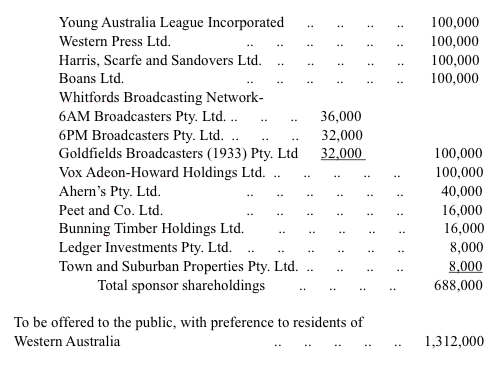
A condition of the allotment to sponsors, none of whom it was proposed would hold more than 5 per cent of the capital, was that the shares would not be sold for three years from the date of allotment without the approval of the directors. Comparison of the proposed shareholders in the two companies seeking the second commercial television licence for Western Australia provides evidence that two different social groups were represented. Swan Television Limited was an amalgamation of in-the-main newly self-made men, while Western Television Services represented The Establishment of older businesses.
In an interview, Sir James Cruthers told me that his boss J.E. Macartney came to him and said that he thought that the people behind Swan Television were ‘…pretty good people…’ and that they should be helped with their application. It was pointed out to Cruthers that the other application was from a group headed by Rupert Murdoch. Macartney’s instruction was to contact Bob Mercer (the proposed General Manager of STW9) to assist him. Cruthers does not remember whether that happened but that it was more likely to have been their lawyers (David Speed and Associates). He does remember going to Melbourne to stay at the Southern Cross Hotel and that after each session the STW9 lawyers would come to his room with Hearing transcripts and then ask his advice. He wrote a lot of questions for them to use at the Hearing. Cruthers concluded with, ‘Really, to put it in a nutshell, I helped them to prepare the application and then advised them when the inquiry was being held, very substantially, and…they got the licence of course. So we, poor old Rupe, [Murdoch] we beat him twice. [chuckles].’ Dennis Cullity has no memory of this having happened, so apparently it was a clandestine arrangement. To a very large degree, James Winter Cruthers was the instrument of Murdoch’s defeat on two occasions. Cruthers told me that he had never discussed the matter with Murdoch although he has worked closely with him for almost twenty years.
The Broadcasting Control Board reported on the two applications, making mention of the fact that they were both assisted by companies and enterprises from outside the State. In the case of Swan Television the assistance came from Ansett Transport Industries, the parent company of Austarama Television Pty. Ltd., who had gained the license to operate Channel 0 in Melbourne and Thomson Television (International) Ltd. which operated television stations in Scotland and other parts of the British Commonwealth. Western Television Services was assisted by News Ltd., Adelaide which at that time held 52.2% of the shares in Southern Television Ltd. The General Manager of NWS helped prepare the application and gave evidence on their behalf at the hearing. A representative of Harris Scarfe and Sandovers which was owned by Electronic Industries Ltd., of Melbourne gave technical evidence for WTS Limited. The Board concluded that the application by Swan Television Ltd., was the more satisfactory and in general their evidence better supported their proposal. It was noted,
The Chairman Mr. D.M. Cullity and the proposed General Manager [R.J. Mercer] both had a good grasp of the issues and a satisfactory understanding of the financial, technical and program aspects of the conduct of a television station in Perth.’
Cullity was high in his praise for the three ‘silks’ who had presented both Company’s cases, but qualified the reason for the success of Swan Television Limited by saying, ‘I think it was the integrity of our position that got us there.’
The era of the monopoly was past. TVW7 would now face the prospect of competition in the form of STW Channel 9. It will always be a matter of conjecture as to whether there would have been a different result without the input of Sir James Cruthers.
Conclusion:
In conclusion, it can be reasonably maintained that the contest for the first commercial television licence in Western Australia was really between the two major press companies, West Australian Newspapers Limited and News Limited through their Perth subsidiary Western Press Limited. The former company’s interest was represented by TVW Limited which was much better prepared and used the concept of being ‘local’ as their biggest argument to defeat the latter’s Western Television Services Limited. The representatives of TVW Limited had studied the basics of running a television station and the financial structure was carefully worked out. They had detailed projections of staffing needs, intended hours of operation and types of programming to be offered. In light of the fact that there ‘…were no Australian content rules until 1960 when the Australian Broadcasting Control Board introduced the extremely modest requirement that overall content was to be 40 per cent with four hours a day in peak time.’ TVW7s projection was forward thinking. On the other hand, those speaking for WTS Limited had obviously not done their homework properly and just how their project would be financed was unclear.
Rupert Murdoch’s statement that, ‘I will retire as soon as I possibly can…There is no attempt to build an empire or anything like that. It would not interest me.’, was in the light of subsequent events an astounding under-valuation of his own capacity and propensity.
TVW Channel 7 went on-air in October 1959 and in the first seven years of operating as the sole commercial station in the local market, had established an entrenched position. They had established a policy of a high percentage program-content by way of local ‘live’ production, thereby setting a model which the management of the new STW9 would be forced to follow, both from necessity and perceived community responsibility.
It appears that Murdoch’s second attempt to secure a commercial television licence for Western Australia primarily failed because of lack of preparation. In June 1965 TVW7 would face the prospect of competition in the form of STW Channel 9, who had acquired the right to become Western Australia’s second commercial television station. It is a most interesting point that the management of TVW7 played a substantial part in the choice of their commercial competition for the following 23 years.
Peter Harries March 2004
| Download this page as a PDF (PDF file) | ||
| The page you are accessing is a downloadable PDF file.
You may retrieve this document by clicking the following link: If this does not work, you may need to click and hold (Mac) or right click on the link (PC), then choose “Download to Disk,” “Save Target As…,” or the equivalent. If you do not have Adobe’s Acrobat Reader, you may download it by clicking the following link: |
||









A person essentially lend a hand to make critically posts I would state. That is the very first time I frequented your website page and so far? I amazed with the analysis you made to create this particular post incredible. Magnificent process!